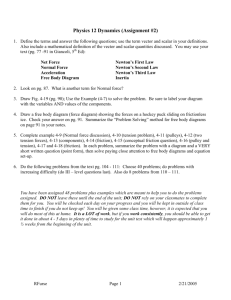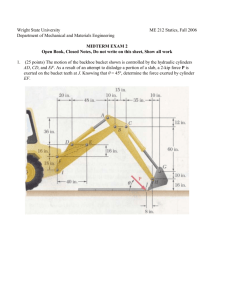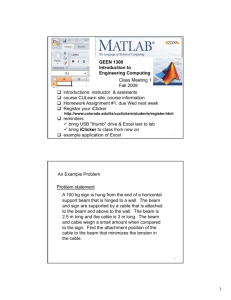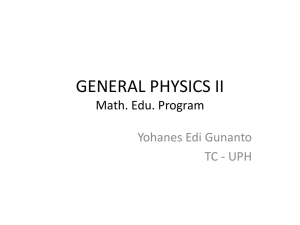Part VIII
advertisement
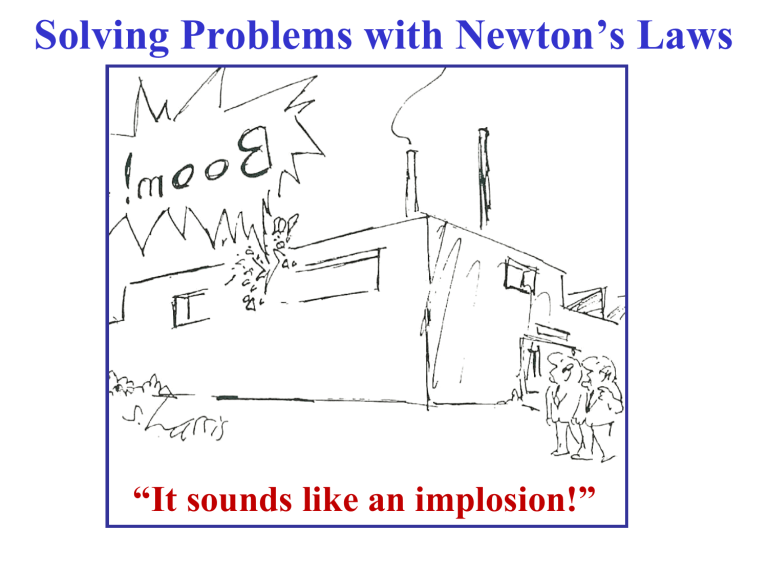
Solving Problems with Newton’s Laws “It sounds like an implosion!” Note that forces are VECTORS!! Newton’s 2nd Law: ∑F = ma ∑F = VECTOR SUM of all forces on mass m We need VECTOR addition to add forces in the 2nd Law! Forces add according to the rules of VECTOR ADDITION! (next chapter) • In this chapter, we consider only 1 dimensional motion & therefore only 1 dimensional Force vectors Problem Solving Procedures 1. Make a sketch. For each object separately, sketch a free-body diagram, showing all forces acting on that object. Make the magnitudes & directions as accurate as you can. Label each force. 2. Apply Newton’s 2nd Law separately to each object. 3. Solve for the unknowns. Note that this often requires algebra, such as solving 2 linear equations in 2 unknowns! Applications & Examples of Newton’s 2nd Law in 1 Dimensional Motion Transmitting Forces • Strings exert a force on the objects they are connected to –This also applies to cables, ropes, etc. • The mass of the cable may have to be taken into account • Pulleys can redirect forces • Forces can be amplified Tension • Strings exert a force on the objects they are connected to – Cables & ropes act the same way • The strings exert force due to their tension • The ends of the string both exert a force of magnitude T on the supports where they are connected. T is the tension in the string. Tension Example – Elevator Cable • Two forces are acting on the compartment – Gravity acting downward – Tension in cable acting upward, T • Assume an acceleration upward • Applying Newton’s Second Law gives T- mg = ma • Now consider the cable – Assume the cable is massless • Applying Newton’s 2nd Law gives: TC = T • Tension is the same for all points along the cable • True for all massless cables • Tension has force units Cables with Mass • Apply Newton’s 2nd Law to the cable • To support the cable, the upper tension, T1 must be larger than the tension from the box, T2 • If there is no acceleration, Newton’s 2nd Law is T1 -T2 - mcable g = 0 • We can assume a massless cable if the mass of the cable is small compared to the other masses in the problem. Single Pulleys • We often need to change the direction of the force. • A simple pulley changes the direction of the force, but not the magnitude – See diagram – Assume the rope and pulley are both massless – Assume the cable does not slip on the pulley Pulleys To Amplify Forces • The person exerts a force T on the rope. • The rope exerts a force 2T on the pulley. • This force can be used to lift an object. • More complex sets of pulleys can amplify an applied force by greater factors. – The distance decreases to compensate for the increase in force Example (“Atwood’s Machine”) Two masses suspended over a (massless frictionless) pulley by a flexible (massless) cable “Atwood’s machine”. Example: Elevator & counterweight. Figure: Counterweight mC = 1000 kg. Elevator mE = 1150 kg. Calculate a) Elevator’s acceleration. b) Tension in the cable. aE = - a aC = a a a Free Body Diagrams General Approach to Problem Solving 1.Read the problem carefully; then read it again. 2.Draw a sketch, then a free-body diagram. 3.Choose a convenient coordinate system. 4.List the known & unknown quantities; find relationships between the knowns & the unknowns. 5.Estimate the answer. 6.Solve the problem without putting in any numbers (algebraically); once you are satisfied, put the numbers in. 7.Keep track of dimensions. 8.Make sure your answer is REASONABLE! Example Two boxes connected by a lightweight (massless!) cord are resting on a smooth (frictionless!) table. mA = 10 kg & mB = 12 kg. A horizontal force FP = 40 N is applied to mA. Calculate: a. Acceleration of the boxes. b. Tension in cord connecting the boxes. Free Body Diagrams Problem FT1 m1 = m2 = 3.2 kg, m1g = m2g = 31.4 N Acceleration a = 2.0 m/s2 a m1g FT2 for EACH bucket separately!!! Take up as positive. Bucket 1: FT1 - FT2 - m1g = m1a (1) Bucket 2: FT2 - m2g = m2a (2) FT2 a m2g Calculate FT1 & FT2 Use Newton’s 2nd Law: ∑Fy = ma From (2), FT2 = m2(g + a) = (3.2)(9.8 + 2.0) or FT2 = 37.76 N Put this into (1) FT1 - m2(g + a) - m1g = m1a Gives: FT1 = m2(g + a) + m1(g+a) or FT1 = (m2+m1) (g + a) = 75.5 N Problem FT FT FP a a mg Acceleration a = 2.0 m/s2 m = 65 kg, mg = 637 N Calculate FT & FP Take up as positive. Newton’s 2nd Law: ∑F = ma (y direction) on woman + bucket! FT + FT - mg = ma 2FT - mg = ma FT = (½)m(g + a) = 383.5 N Also, Newton’s 3rd Law says that FP = - FT = -383.5 N
